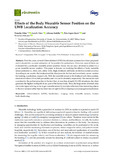Mostrar el registro sencillo del ítem
Effects of the body wearable sensor position on the UWB localization accuracy
| dc.creator | Otim, Timothy | es_ES |
| dc.creator | Díez, Luis E. | es_ES |
| dc.creator | Bahillo, Alfonso | es_ES |
| dc.creator | López Iturri, Peio | es_ES |
| dc.creator | Falcone Lanas, Francisco Javier | es_ES |
| dc.date.accessioned | 2020-05-12T11:15:26Z | |
| dc.date.available | 2020-05-12T11:15:26Z | |
| dc.date.issued | 2019 | |
| dc.identifier.issn | 2079-9292 | |
| dc.identifier.uri | https://hdl.handle.net/2454/36867 | |
| dc.description.abstract | Over the years, several Ultrawideband (UWB) localization systems have been proposed and evaluated for accurate estimation of the position for pedestrians. However, most of them are evaluated for a particular wearable sensor position; hence, the accuracy obtained is subject to a given wearable sensor position. This paper is focused on studying the effects of body wearable sensor positions i.e., chest, arm, ankle, wrist, thigh, forehead, and hand, on the localization accuracy. According to our results, the forehead and the chest provide the best and worst body sensor location for tracking a pedestrian, respectively. With the wearable sensor at the forehead and chest position, errors lower than 0.35 m (90th percentile) and 4 m can be obtained, respectively. The reason for such a contrast in the performance lies in the fact that, in non-line-of-sight (NLOS) situations, the chest generates the highest multipath of any part of the human body. Thus, the large errors obtained arise due to the signal arriving at the target wearable sensor by multiple reflections from interacting objects in the environment rather than by direct line-of-sight (LOS) or creeping wave propagation mechanism. | en |
| dc.description.sponsorship | This work was supported in part by the Research Training Grants Program of the University of Deusto, in part by REPNIN+ under Grant TEC2017-90808-REDT, in part by Ministerio de Ciencia, Innovación y Universidades, Gobierno de España under Grant RTI2018-095499-B-C31 (MCIU/AEI/FEDER, UE). | en |
| dc.format.extent | 14 p. | |
| dc.format.mimetype | application/pdf | en |
| dc.language.iso | eng | en |
| dc.publisher | MDPI | en |
| dc.relation.ispartof | Electronics, 2019, 8 (11), 1351 | en |
| dc.rights | © 2019 by the authors. Licensee MDPI, Basel, Switzerland. This article is an open access article distributed under the terms and conditions of the Creative Commons Attribution (CC BY) license | en |
| dc.rights.uri | http://creativecommons.org/licenses/by/4.0/ | |
| dc.subject | Ultrawideband (UWB) | en |
| dc.subject | Localization | en |
| dc.subject | Ranging | en |
| dc.subject | Body wearable sensors | en |
| dc.subject | Human body shadowing | en |
| dc.title | Effects of the body wearable sensor position on the UWB localization accuracy | en |
| dc.type | info:eu-repo/semantics/article | en |
| dc.type | Artículo / Artikulua | es |
| dc.contributor.department | Ingeniería Eléctrica, Electrónica y de Comunicación | es_ES |
| dc.contributor.department | Ingeniaritza Elektrikoa, Elektronikoa eta Telekomunikazio Ingeniaritza | eu |
| dc.contributor.department | Institute of Smart Cities - ISC | es_ES |
| dc.rights.accessRights | info:eu-repo/semantics/openAccess | en |
| dc.rights.accessRights | Acceso abierto / Sarbide irekia | es |
| dc.identifier.doi | 10.3390/electronics8111351 | |
| dc.relation.projectID | info:eu-repo/grantAgreement/ES/2PE/TEC2017-90808 | en |
| dc.relation.publisherversion | https://doi.org/10.3390/electronics8111351 | |
| dc.type.version | info:eu-repo/semantics/publishedVersion | en |
| dc.type.version | Versión publicada / Argitaratu den bertsioa | es |



